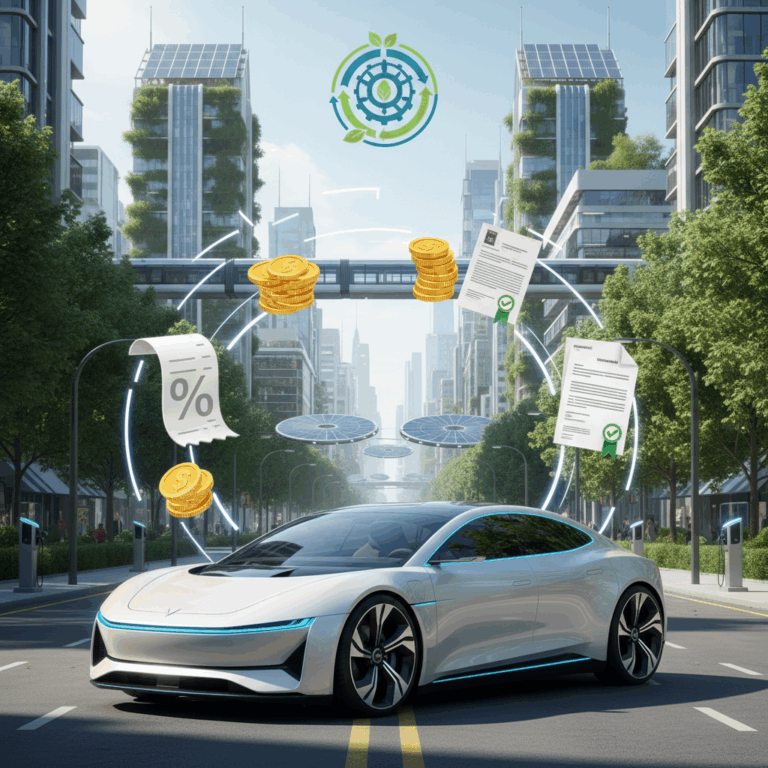Types of EV Tax Incentives
Governments worldwide offer various tax incentives and rebates to encourage the purchase of electric vehicles (EVs). These incentives aim to promote sustainable mobility and reduce harmful emissions.
Common forms include tax credits, deductions, exemptions, and direct rebates. These financial benefits help lower the overall cost of EV ownership, making them more accessible to buyers.
Tax Credits and Deductions
Tax credits directly reduce the amount of tax owed by the EV buyer, often amounting to thousands of dollars or euros. This reduces the financial barrier to purchasing new and used electric vehicles.
Deductions lower taxable income based on EV expenses, offering another way to decrease tax liability. For example, buyers may deduct a percentage of the EV cost when filing annual taxes.
In countries like Spain and the US, credits and deductions significantly impact EV affordability and are often combined with other incentive programs for greater benefit.
Exemptions and Rebates
Exemptions include relief from certain taxes such as vehicle registration or annual circulation taxes, which can save owners considerable costs over time. These are common at local and national levels.
Rebates are often offered as upfront discounts or cash-back at the point of sale, effectively lowering the purchase price immediately. This makes EVs more competitively priced against traditional vehicles.
Examples include free or discounted parking in some municipalities and exemptions from road or registration taxes, all reinforcing the economic appeal of EV ownership.
EV Incentives by Country
Spain’s Tax Deductions and Regional Benefits
In Spain, buyers can deduct up to 15% of the purchase price of an electric vehicle on their income tax return, enhancing affordability significantly. This benefit works alongside the Plan MOVES III program.
Additionally, there are exemptions and reductions on registration taxes and mechanical traction vehicle levies, which vary by autonomous community and municipality. These regional benefits create tailored support for EV adoption.
Many areas also offer discounts or complete exemptions from circulation taxes, plus perks like free or discounted parking for EV owners. These incentives mostly apply to vehicles registered for the first time and not used commercially.
United States Federal and State Credits
The U.S. federal government provided up to $7,500 in tax credits for new EVs and up to $4,000 for used ones until September 2025 under the Inflation Reduction Act. This significantly helped reduce buying costs.
Starting in 2024, the credit was made available at point of sale, allowing direct discounts from dealers rather than tax refunds later, simplifying the incentive process for buyers.
Despite the federal credit ending for vehicles purchased after September 30, 2025, various states maintain their own incentive programs, offering additional rebates or tax credits that complement federal support.
Portugal’s Vehicle Tax Exemptions and Municipal Programs
Portugal supports EV buyers with exemptions from vehicle tax (ISV) and annual circulation tax for fully electric cars, lowering ownership costs notably. These exemptions aim to encourage clean vehicle use nationwide.
No direct support exists for hybrid vehicles; however, many municipalities provide non-fiscal benefits like free parking or subsidies for home charging station installations to stimulate electric mobility.
Such incentives align with Portugal’s goals to phase out combustion engine vehicles by 2035, promoting environmental sustainability through progressive, localized programs.
Eligibility and Conditions
EV tax incentives typically have specific eligibility criteria for both vehicles and buyers. These conditions ensure that benefits target genuine electric vehicle adoption and promote environmental goals.
Understanding these requirements is crucial for potential buyers to qualify for incentives and make the most of available benefits that reduce the total cost of EV ownership.
Vehicle and Buyer Requirements
Eligible vehicles usually must be new or recently registered electric cars, with restrictions on commercial use in some regions. This ensures incentives support personal use and sustainable transport.
Buyers often need to meet income limits or residency requirements to qualify, preventing high-income individuals or non-residents from receiving benefits intended for broader public interest.
In some countries, incentives exclude hybrid vehicles or impose specific battery capacity and emissions standards to focus support on fully electric models.
Impact and Future Outlook
EV tax incentives have played a crucial role in accelerating the adoption of electric vehicles by reducing purchase and ownership costs significantly. This fosters a shift towards cleaner transportation.
As governments pursue climate goals, these incentives support sustainable mobility and contribute to lowering greenhouse gas emissions, making EVs a mainstream option for many consumers.
Role in Promoting Sustainable Mobility
Tax incentives create economic motivation for consumers to choose electric vehicles over traditional gasoline cars, supporting national and local efforts to combat air pollution and climate change.
They also encourage automakers to innovate and expand EV offerings, ensuring a wider range of affordable models meets various needs, thus enhancing accessibility to clean transport.
In addition, these incentives reduce the overall environmental impact by lowering fossil fuel dependency and promoting energy-efficient technologies in the automotive sector.
Changes and Expiration of Incentives
Several incentives have expiration dates or phase-out schedules, such as the U.S. federal EV tax credit ending after September 2025, which may influence future EV market dynamics negatively.
Some regions may revise or reduce support over time as EV adoption grows and market conditions improve, potentially shifting focus toward infrastructure and other sustainable transport solutions.
Insight on Incentive Evolution
Governments continuously adjust EV incentives based on economic viability and policy goals, balancing short-term subsidies with long-term environmental objectives to ensure sustainable growth.
Future policies may emphasize electrification of fleets, increased charging infrastructure, and integration with renewable energy, reflecting an evolving approach to sustainable mobility beyond just tax breaks.







